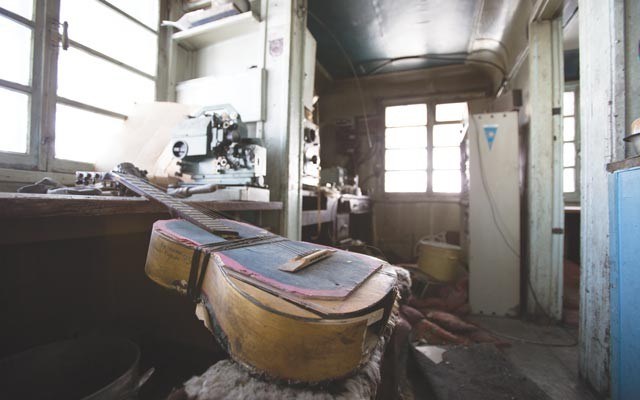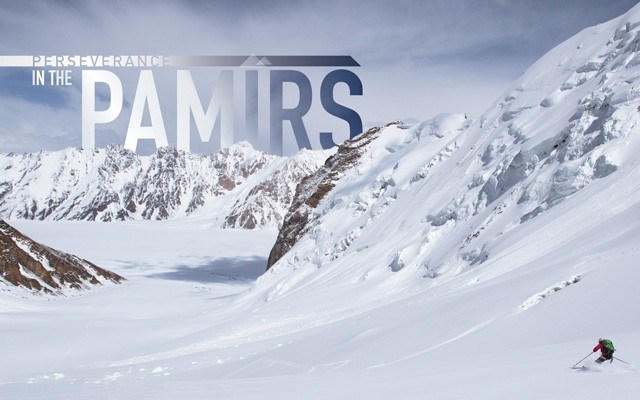
Gritting my teeth, I feel like a strongman hauling an airplane across the tarmac as I tug at my overloaded sled and plod through the glacial snow. At 5,000-metre elevation every breath feels laboured, the sun beats down from the sky and radiates from the snow under my skis. The heat is unbearable, yet I'm shrouded head to toe to avoid painful sunburn in the days ahead.
Often referred to as the "Roof of the World" due to their inaccessibility and mysterious grandeur, the Pamir Mountains of Tajikistan knot the Himalayas with the Tian Shan, Karakoram, Kunlun and Hindu Kush mountains. West of China and North of Afghanistan, Tajikistan sits roughly in the middle of Central Asia with mountains covering 93 per cent of its landscape. Glacier-fed streams and rivers are the lifeblood of the Pamiri people, irrigating their modest farmlands for thousands of years.
The source of all this water silently flows beneath our feet on the Fedchenko Glacier. At 77 kilometres long, and lined with hundreds of unnamed peaks, this glacier — the largest non-polar one in the world — was our chosen destination for the most far-flung and ambitious expedition any of us had ever attempted.
The entry point to Tajik National Park in the town of Poi Mazar sees only about 70 alpinists per year travelling through, usually en route towards mountain climbing objectives such as the 7,495-metre Ismoil Somoni Peak (originally named Stalin Peak in 1933 and later changed to Peak Communism in 1962 before adopting its current name in 1998). Skiers are rarely seen in the region, preferring to attempt ski mountaineering objectives in neighbouring Kyrgyzstan and Afghanistan.
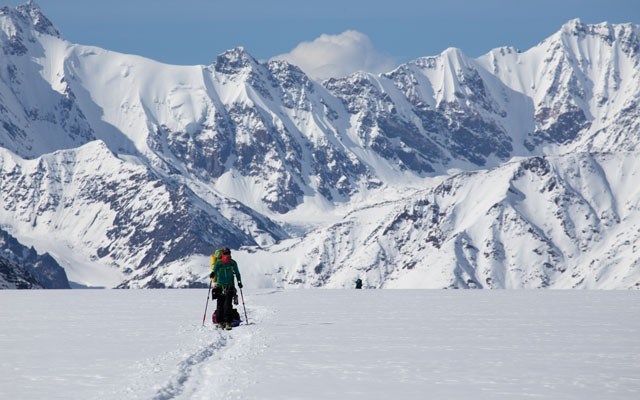
September, 2012 — The proposal
It sounded like the trip of a lifetime. In the fall of 2012 I was introduced, along with ski mountaineer Holly Walker, to Emelie Stenberg, a ski guide from Revelstoke, at a chic North Vancouver restaurant. Emelie opened a folder with all the documentation she had found on the area, including a British Alpine Journal article from 1995 about four Russians traversing the entire Pamir Range and living off daily rations of spoonfuls of rice. She spread the maps across the table and pointed to a long white mass in the middle of the Pamirs, running her finger along the length of the Fedchenko.
It would not be easy. Countless hurdles lay ahead, everything from securing funding to obtaining special travel permits to a former Soviet state. With limited access to vehicles and aircraft, this would need to be a purely self-supported and self-propelled trip, without the relative convenience of food drops and porters.
But the very idea of travelling to one of the most-remote mountain ranges in the world and crossing this immense glacier was far too alluring to pass up. We adjourned from the restaurant and for the entire drive back to Whistler, Holly and I brainstormed everything from gear sponsorships to potential candidates to join our aspiring expedition.
Later that winter Emelie, Holly and I made the collective decision to postpone the trip from the spring of 2013 until the following year. We needed more funding, more time for planning logistics and most of all, we needed one or two more people to join the team to ensure its success. By February 2014 mountain guide Zeb Blais and outdoor guide Selena Cordeau had committed to joining the expedition, the prospect of exploring a mountain range that so few people had heard of making it an easy decision.
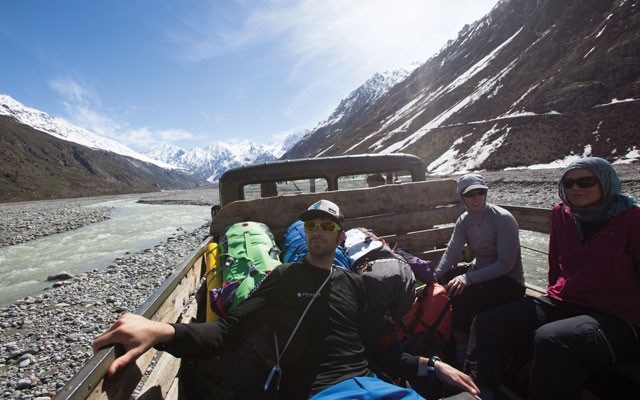
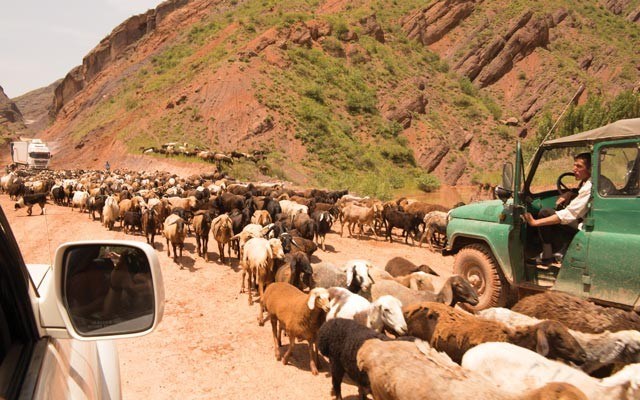
May 2, 2014 (Day 1) – Reality check
The rumbling GAZ-66 Soviet troop transport truck plunged through another thigh-deep river, jostling the mountain of duffles and backpacks and nearly knocking us off our seats. The bumpy shuttle ride to the foot of the RGS glacier — our gateway to the Fedchenko — greeted us with clear skies and warm weather, but upon arrival to the rocky and snowless toe of this subsidiary glacier, the enormity of the task ahead began to sink in.
We bade farewell to Jafar and his son-in-law, who in return for payment had driven us as far as they could up this ancient glacial river bed in Jafar's stout troop carrier. With hundreds of kilos of food and equipment sitting in a pile in front of us, we began our month-long journey. We'd only walked about 400 metres away before we hit our first major obstacle, the River Abdulkhahor. May's spring glacial runoff generated a swift flow much too high for crossing, so we built a Tyrolean Traverse zipline over the remains of a wrecked bridge and ferried our supplies to the opposite bank. Taking an entire afternoon to gain a distance within earshot of our drop-off, it quickly became apparent that our projection of a four-to-five-day approach to Fedchenko had been grossly underestimated.
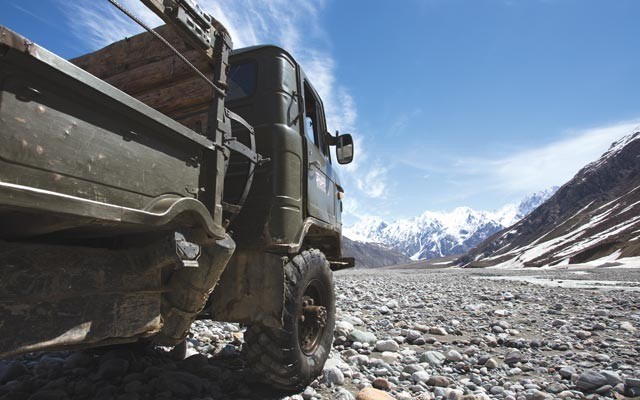
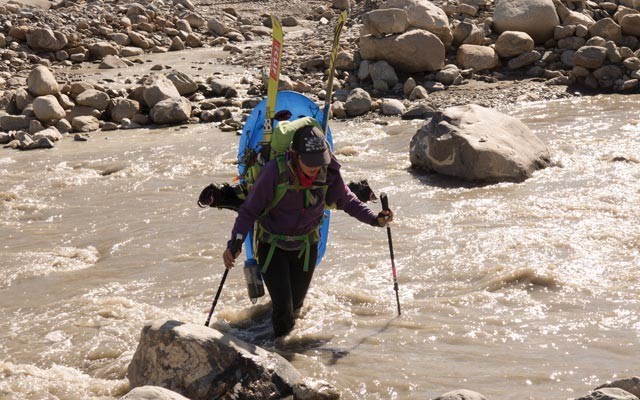
It was going to be a long month.
May 6, 2014 (Day 5) — ever higher
After four days of hiking in wet running shoes, we'd finally reached a consistent snow line and could equip our skis and boots rather than carrying them on our backs. After lumbering up steep shale backcarrying supplies to the next camp, just being able to move across snow on our skis gave the team a much needed boost in morale.
Fluttering next to me on the skin track were two butterflies that followed our route up the Russian Geographical Society (RGS) Glacier — a subsidiary glacier and gateway to the Fedchenko. The beautiful display of these colourful insects was a welcome distraction as I kicked my skis forward under the back-breaking load of my backpack. All around us snow pockets released under the spring heat, the avalanches were all a safe distance away and causing echoes throughout the valley like ocean waves crashing on a distant shoreline.
A beach holiday. That would have been a great choice to spend the month of May — what was I thinking?
The daydream faded as I approached our third camp of the trip at 3,500m. Now looking at the headwall, the last obstacle on the approach before we can finally set foot on the Fedchenko. The heat was overwhelming and the team retreated into the shade of the kitchen tent and rested until the sun had past its burning apogee.
Later that afternoon during the final retrieval of gear from our previous cache I saw the butterflies again, this time lying lifeless on the snow next to the skin track. I took pride in the fact that these two adventurous insects chose to spend part of their short lives chasing humans up remote glaciers. The metaphor stuck with me for the rest of the trip — life is too short to not explore the world to one's potential.
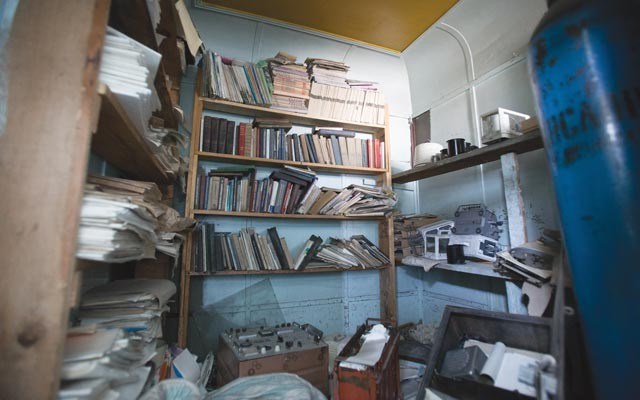
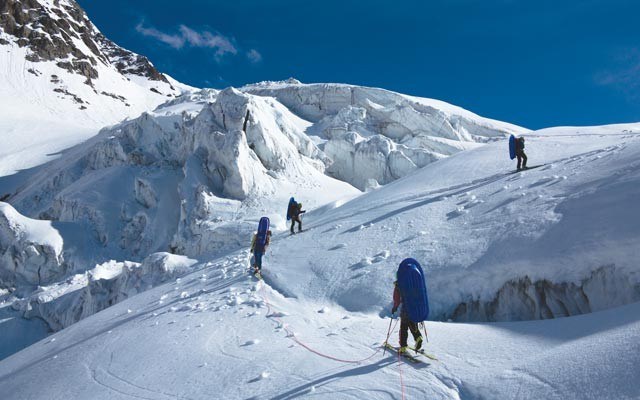
May 9, 2014 (Day 8) – the world's most remote museum
The headwall was behind us and we were finally dragging our loads on sleds. Cresting over the col we could finally see the Fedchenko in all its glory. On an outcropping we could see the ageing meteorological station at 4,200 metres, the milestone on the map that helped keep us going for the last week. First built in the 1930s and hosting various research teams until the mid-2000s, the structure now stood as an eerie time capsule of Tajik and Soviet history. With dusty weather instruments, a broken guitar, walls adorned with preserved chicken feet, and forgotten `80s action films, the station felt like the world's most remote museum. Once a flourishing bastion of scientific research, the derelict structure was abandoned once again, this time out of fear of lingering spirits. Outside we sat with our backs leaning against the exterior of the station, passing around a bottle of Tajik cognac. The booze was worth its weight in gold, breaking tensions that had already manifested in the first week of the expedition.
May 16, 2014 (Day 15) – the wake up call
The sun had only been up for a couple hours, but we were already retreating back to the camp. Our attempt to climb and ski one of the hundreds of unnamed peaks lining the Fedchenko ended with a rude awakening and brutal reality check. In our haste to gain the ridge we triggered a Size 2 avalanche that caught two of our party, burying one completely. Quick response by Emelie, Selena and Holly meant that Zeb was only under the snow unable to breathe for less than a minute, but we were all visibly shaken. Miraculously, no one was hurt and no crucial gear went missing in the debris.
Back at camp we sat in the kitchen tent and discussed the event and what caused it. Everyone wanted to ski the slope — it's why we came from across the world to these mountains after all. But the previous two weeks of labourious travel and unsuitable skiing conditions had built up a thirst that needed to be quenched, at the expense of sound decision making. One by one, every member of the team confessed how the desire to ski clouded their judgement of the situation, the cold morning forcing everyone to rush out of camp rather than sit over breakfast and discuss the potential hazards on our route.
It was human factor, pure and simple. A built up collective desire to get a first descent under our belts on this expedition had allowed a potentially fatal incident to catch us by surprise. The group was unanimous in deciding that we should take no more unnecessary risks in this foreign terrain with such an unpredictable snowpack.
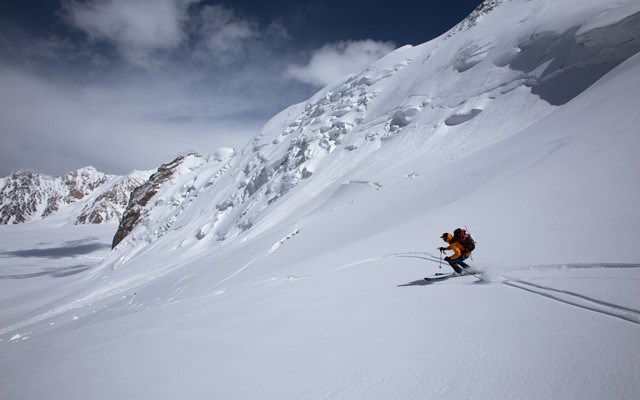
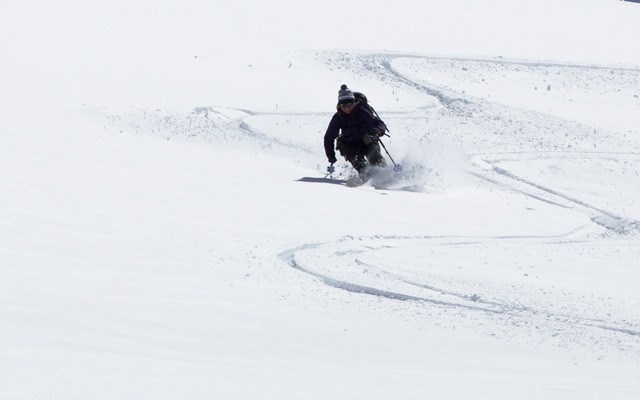
May 22, 2014 (Day 21) – isolated monotony
I awoke to yet another buried campsite on the fourth day of this unrelenting storm. The team was getting stir crazy, the hours of digging out our tents and kitchen area a welcome task to break up the monotony of being confined to camp. To make matters worse, we were now out of coffee. A half packet of hot chocolate was the only morning beverage left to help us mentally prepare for the days ahead. Our Swiss-based contact Sebastian dutifully sent us weather updates on our inReach satellite communicator, noting that today the storm should be clearing. The familiar wind whipping snow into our bowls of bland oatmeal didn't fill me with confidence.
We passed the day with the typical mix of reading novels, digging out the tents and even attempting weird culinary experiments involving our excess ingredients of butter, sugar and a plethora of pumpkin seeds. Moments after we finished yet another dinner of ramen noodles and textured vegetable protein, the wind all of a sudden stopped and the clouds parted. The forecast was right! Everyone reached for their cameras as the temperature dropped by about 20 degrees, eagerly snapping photos of the snow-covered peaks that we hadn't seen since we dug in to camp.
The next day we would make the final push to reach the head of the Fedchenko.
May 23, 2014 (Day 22) – A small victory
Temperatures plummeted to minus 30 degrees Celsius just in time for the morning of our final march on the glacier's terminus. Fingers and toes ached as we struggled to tighten harnesses and slide on ski boots in the bitter cold. The rising sun provided little relief from the frigid headwind, but if we wanted to make the head of the glacier, our only chance was to keep moving.
Selena bowed out a few kilometres from camp, the last few days of illness not conducive to another big day of high-altitude travel. The remaining four of us continued on, the towering outline of Peak Revolution (6,954m) providing a much-needed dose of inspiration. After reaching the main bowl at the terminus of Fedchenko, we decided we had time to ascend a col to the west, just to see what was on the other side.
Topping out at 5,500 metres, we were greeted by the vast expanse of the Yazgulom Valley, its own formidable glacier flowing westward with jagged peaks and overhanging seracs like no other mountain range we had witnessed. The frustration of barely skiing on this expedition due to an incredibly unstable snowpack faded, as we realized how far and high we had come after two years of planning and three weeks of insurmountable suffering. After reconnecting with Selena we still faced a five-day exit through broken glaciers, riverbeds and boulder fields, but at that moment, high above the white sea of the Fedchenko, nothing could dampen our spirits.
We made it. Now we just had to get home.
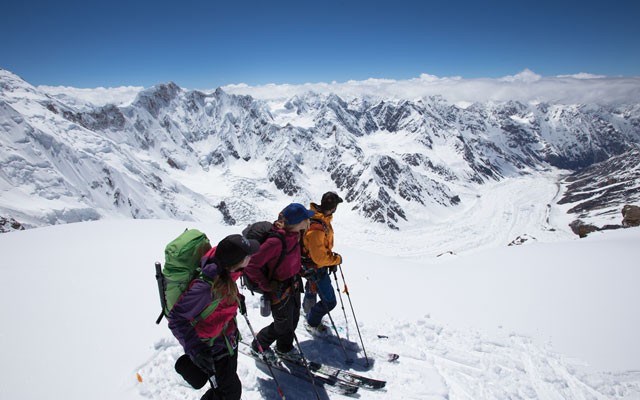
May 28, 2014 – The Finale
It took us four days from our final camp on the glacier to reach the pickup point and we had just one last retrieval to go. Ironically our final day of the expedition would also be our biggest, backtracking a total of 42 kilometres up the river bed and back again to collect the last of our gear. Walking a marathon through rocks, sand and icy rivers was both physically and mentally exhausting — both Holly and I were already struggling before we reached the cache at the halfway point. Sliding down the shale in a vain attempt to keep my pace up, I stepped awkwardly on a rock and turned my ankle, cursing loudly. I still had 21 kilometres to go, now under heavy load.
The pain set in about 20 minutes later, slowing my pace to a crawl. Luckily I had my meds on me and began popping Advils in order to keep moving and reduce the shooting pain emanating from my ankle. Holly was still a hundred metres behind, exhausted but diligently placing one foot in front of the other. On the horizon, a dark cloud formed. Whether it was rain or dust we didn't know. We were only a few kilometres away from the pick-up point when the wind tried to blow us back towards the Fedchenko.
On our final river crossing, we noticed that the water had deepened throughout the day. After getting soaked up to my belly button and standing on the opposite bank, I watched Holly as she carefully crabwalked through the river, bracing against the flow. She screamed as the water caught the sled tied to her back, my outstretched pole giving her a lifeline to grasp to avoid being washed away. We were almost there.
The wind intensified and the rain followed, soaking us for the final kilometre. The campsite was in view, the rest of the team already preparing our final meal in this valley. I turned to Holly and said, "We're going home."
Reflecting on this journey one year later, lessons were learned and experience was gained, but there are still no regrets. Missing the opportunity to ski in the Pamirs took a while to come to terms with, but seeing what five humans are capable of after a month in the wilderness with just a duffle bag full of food and gear still surprises me. The months of fitness training, hauling a backpack weighted with cameras and soup cans, only prepared me so much for the endurance needed for 28 days of high-altitude glacier travel. While our team achieved the primary objective of crossing the glacier, the more tangible secondary goal of first ski descents in the Pamir Mountains left us wanting more. Future trips for all of us will likely look towards more refined objectives and a shorter trip length without such reliance on human-powered exploration.
Crossing the Fedchenko Glacier ended up being far more challenging than we expected, but nothing that couldn't be overcome by five determined souls.
The Fedchenko Expedition was undertaken by Zeb Blais, Holly Walker, Emelie Stenberg and Selena Cordeau, with the author along for the ride. The trip was made possible by grants from the Alpine Club of Canada, Polartec and MEC.

